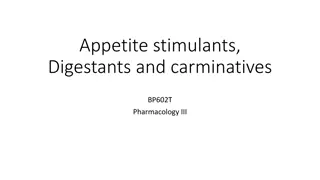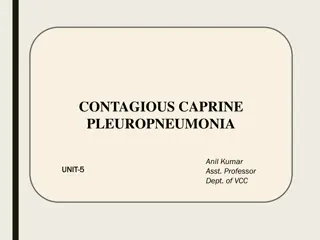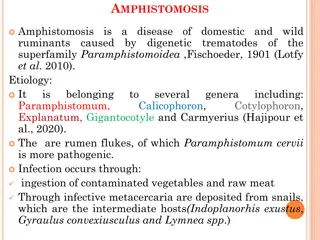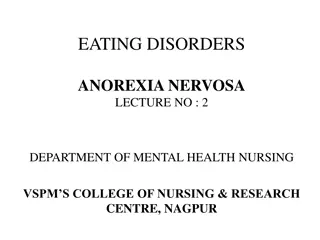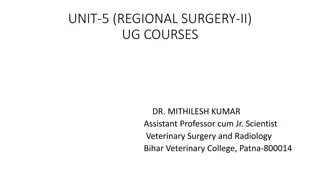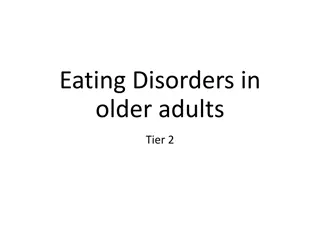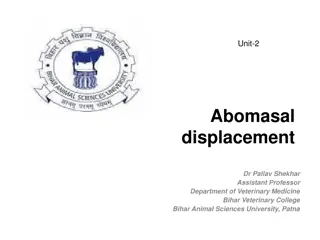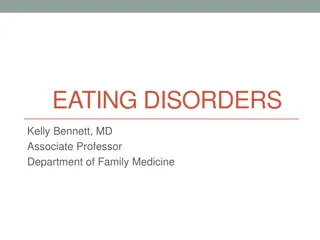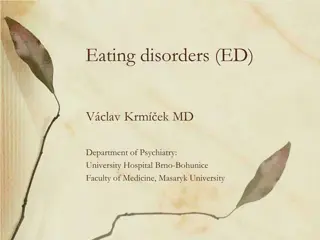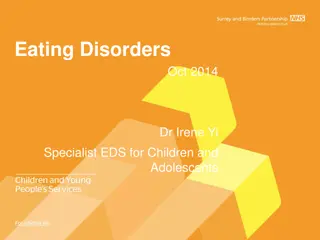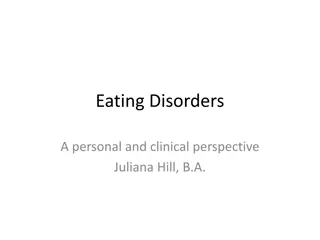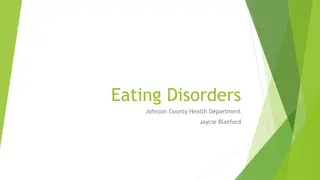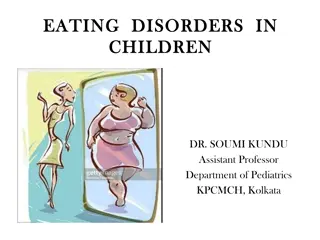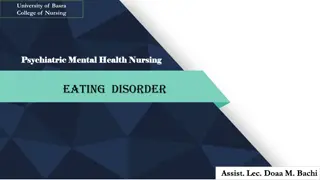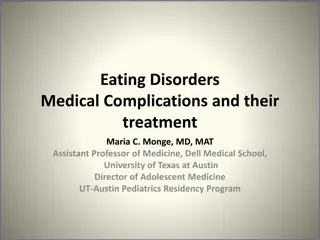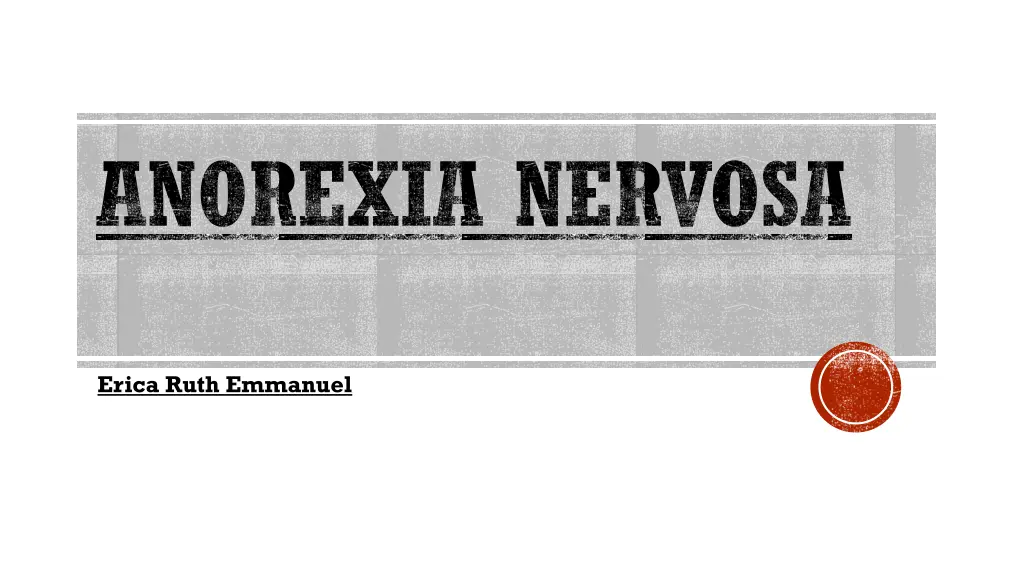
Understanding Anorexia Nervosa - Symptoms, Statistics, and Diagnosis Criteria
Learn about anorexia nervosa, an eating disorder characterized by low weight, fear of gaining weight, and distorted body image. Explore statistics on its prevalence and diagnostic criteria as per DSM-5 and ICD-10 for a better understanding.
Download Presentation

Please find below an Image/Link to download the presentation.
The content on the website is provided AS IS for your information and personal use only. It may not be sold, licensed, or shared on other websites without obtaining consent from the author. If you encounter any issues during the download, it is possible that the publisher has removed the file from their server.
You are allowed to download the files provided on this website for personal or commercial use, subject to the condition that they are used lawfully. All files are the property of their respective owners.
The content on the website is provided AS IS for your information and personal use only. It may not be sold, licensed, or shared on other websites without obtaining consent from the author.
E N D
Presentation Transcript
ANOREXIA NERVOSA Erica Ruth Emmanuel
INTRODUCTION TO ANOREXIA NERVOSA
Definition: Anorexia nervosa, is an eating disorder, specified by low weight, food restriction, fear of gaining weight, distorted view of their body, and a strong desire to be thin. There are two types of anorexia nervosa, restricting, where people reduce the amount they eat, and binge/ purge eating, this is where underweight individuals eat large amounts of foods and then getting rid of that food by laxatives or vomiting. Some preventions can be taken such as putting importance on their personality rather than their looks, encouraging honest feelings to be expressed, building up self-esteem, learning about the dangers of dieting, and to make them understand that perfection doesn't exist. We can look for psychological, physical, and behavioral warning signs.
SOME STATISTICS It was found that 24% out of the 228 female participants at Zayed University, Dubai, were found to have disordered eating mindsets and a potential eating disorder. Over 74.8% were disheartened with their current body image. An expected 0.5 to 3.7 percent of females suffer from anorexia nervosa at some point in life and ten percent of males have anorexia. Studies indicate that about 1 percent of women adolescents have anorexia.
DIAGNOSTIC STATISTIC MANUAL CRITERIA 5 AND ICD-10 SYMPTOMS
DIAGNOSTIC STATISTIC MANUAL CRITERIA 5 To be diagnosed with anorexia nervosa according to the DSM-5, the following criteria must be met: Restriction of energy intake relative to requirements leading to significantly low body weight in the context of age, sex, developmental trajectory, and physical health. Intense fear of gaining weight or becoming fat, even though underweight. Disturbance in the way in which one's body weight or shape is experienced, undue influence of body weight or shape on self-evaluation, or denial of the seriousness of the current low body weight.
ICD-10 SYMPTOMS According to the ICD-10 to be diagnosed the all the following guidelines must be met: Bodyweight is maintained at least 15% below that expected (either lost or never achieved), or Quetelet's body-mass index is 17.5 or less. Prepubertal patients may show a failure to make the expected weight gain during the period of growth. The weight loss is self-induced by avoidance of "fattening foods" and one or more of the following: self-induced vomiting; self-induced purging; excessive exercise; use of appetite suppressants and/or diuretics. There is body-image distortion in the form of specific psychopathology whereby a dread of fatness persists as an intrusive, overvalued idea and the patient imposes a low weight threshold on himself or herself. A widespread endocrine disorder involving the hypothalamic-pituitary-gonadal axis is manifest in women as amenorrhea and in men as a loss of sexual interest and potency. (An apparent exception is the persistence of vaginal bleeds in anorexic women who are receiving replacement hormonal therapy, most commonly taken as a contraceptive pill.) There may also be elevated levels of growth hormone, raised levels of cortisol, changes in the peripheral metabolism of the thyroid hormone, and abnormalities of insulin secretion. If onset is prepubertal, the sequence of pubertal events is delayed or even arrested (growth ceases; in girls the breasts do not develop and there is primary amenorrhea; in boys the genitals remain juvenile). With recovery, puberty is often completed
CAUSES/EXPLANATIONS OF THE PSYCHOLOGICAL DISORDER
BIOLOGICAL It is believed that genetics has a role in this disorder. Holland (1988), found where one identical twin had the disorder, it was likely (65%) than their co-twin had the disorder too. For Dizygotic twin pairs, the figure was 5%. High levels of dopamine receptors could lead to anorexia nervosa. Kaye et al. (2004) suggested that high levels of activity in dopamine receptors of the basal ganglia could alter the way people interpret rewards, people with anorexia nervosa cannot get the same pleasure from food like others. There are evolutionary explanations associated with anorexia nervosa. Guisinger (2003) stated that anorexia symptoms of food restriction, hyperactivity, and denial of starvation, were adaptations in response to local famine conditions, where food was extremely scarce. Surbey et al. (1995) suggested that adolescent girls became more anorexic because of evolutionary adaptation. Disturbing high levels of serotonin have been found in suffers from anorexia. Baker et al (1991) found higher serotonin levels in women recovering from anorexia nervosa.
COGNITIVE Involves faulty reasoning about the self, the body, and food/eating. This theory also suggests that individuals with anorexia base their feelings of self-worth disproportionately on physical appearance. Some of the cognitive errors that get processed in these individuals could include: Over Generalizing, "If I fail at controlling my eating, I fail at life", All or Nothing Thinking, "I ate one biscuit...that's blown everything!", Magnifying/ Minimizing, "My weight loss isn't serious" or Magical Thinking, " If I reach size 4 then my life will be perfect. McKenzie et al. (1993) suggested that female patients with this disorder overestimated their body size concerning other women, they judged their ideal weight to be lower than compared patients without an eating disorder.
BEHAVIORAL Society and culture reward thinness, most people think slenderness is a beauty factor in girls and women. Idols and popular stars are always portrayed as slim and attractive. 1800 Japanese female high school teenage students, "85% who were normal weight wanted to be thinner and 45% who were 10-20% malnourished wanted to be thinner." A greater number of teen girls are anxious about their weight and believe that slimness is more attractive. Those individuals who are perfectionists or are star athletes, have high expectations of themselves and desire to be unflawed. Anorexia nervosa can also be caused by family stress. Puberty can also be a trigger
PSYCHODYNAMIC Freud suggested that eating was a replacement for sexual activity. BRUNCH has suggested a more recent explanation into the development of anorexia in terms of poor parenting and the struggle for independence. Clinicians have observed that parents of kids with eating disorders tend to define their children's needs rather than letting them determine their own needs. Brunch interviewed the mothers of 51 children with anorexia and found that they had always anticipated their children's needs, and never permitting the child to feel hungry.
TREATMENT OF ANOREXIA NERVOSA
PSYCHODYNAMIC PSYCHOTHERAPY This type of treatment focuses on changing the thinking and the behavior of a person with an eating disorder. Psychodynamic psychotherapy therapy involves looking at the root causes of anorexia, what the true underlying needs and issues of the patient as the key to recovery. Outpatient psychotherapy is a successful treatment approach for adult women with anorexia. Focal psychodynamic therapy tackles the way negative associations of relationships and disturbances affect the way patients process emotions. Cognitive-behavioral therapy has two focuses: normalization of the eating behavior and weight gain, as well as addressing the problem areas connected to eating disorders, such as deficits in social competence or problem-solving ability.
BIOLOGICAL TREATMENT No medications to treat anorexia were approved because none is effective. Can use antidepressants or other psychiatric medications to help treat these mental health disorders. Psychiatric medications to help treat these mental health disorders. It has been suggested not to begin medications, to treat anxiety and depression, until there has been weight gain.
BEHAVIORAL TREATMENT Behavioral treatment is a type of therapy that is used to treat mental disorders. Identifies and changes self-destructive or unhealthy behaviors. Based on the idea that all behaviors are learned and can be changed. Acceptance and commitment therapy (ACT) are a form of behavioral therapy. Dialectical Behavior Therapy (DBT) is another type of behavioral treatment that is supported by empirical evidence for the treatment of binge eating disorder, bulimia nervosa, and anorexia nervosa.
COGNITIVE TREATMENT This type of treatment diminishes symptoms by correcting dysfunctional cognitions based on negative self-perceptions and expectations. A cognitive- interpersonal treatment for anorexia nervosa is Maudsley Anorexia Nervosa Treatment (MANTRA). Can be used to treat adults with anorexia nervosa. Treatment involved 20 weekly sessions and optional extras. Cognitive Remediation Therapy (CRT) is another type of cognitive treatment for anorexia nervosa.
CHARACTER ANALYSIS
TO THE BONE- ELLEN Ellen is a 20-year-old girl, played by Lily Collins, who in real life struggled with anorexia. Ellen spent a large number of her teenage years battling anorexia. She was forced to drop out of college and return home to her father and stepmother after struggling through in-patient programs and failing to make progress with treatment. During her battle with anorexia, Ellen denies the fact that she has a problem and constantly expresses that she feels "fine and healthy . She was set up with a specialist, Dr. William Beckham, who insisted that Ellen join his inpatient program. Ellen's complex family dynamics triggered her anorexia.
Ellen shows dangerous and severely low weight, participates in extreme exercise and persists in restricting what she eats. Ellen states that she feels anxious about eating, and she habitually uses her forefinger and thumb to measure the circumference of her arms, frightful that she might have gained in weight and size. One behavior of anorexia that Ellen exhibits are wearing loose clothing. Ellen shows obsessive attention to counting calories and hints at a fascination with thoughts of food. Another behavior that Ellen demonstrates is excessive exercise. In an examination done by her doctor he noted loss of menstruation, and an increase of fine, soft body hair.
MANAGEMENT AND CONCLUSION
HOW DOES ONE LIVE/MANAGE THEIR DISEASE THROUGH HIS/HER LIFE? The first step to dealing and managing anorexia nervosa is to accept there is a problem. Family and friends can contribute to management by reassuring them that they are not alone. Avoiding places, people, and activities that trigger the obsession of being thin help with managing anorexia The most important way to live and manage anorexia would be to seek medical attention, advice, and support from these professionals. Many resources available online such as AED.
CONCLUSION Anorexia nervosa is a severe eating disorder. Estimated to affect 1.0% to 4.2% of women in their lifetime. Whether the individual is manipulated by biological factors or social factors, the consequence is the unchanged: thin and unhealthy. Media uses language to coax people into going on diets and in severe cases turn anorexic. These are serious illnesses that are recognized by the DSM and clinical professionals, they are also deadly. Anorexia affect's both men and women.

